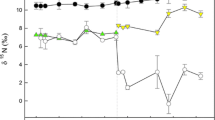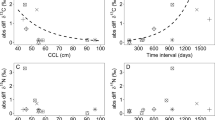Abstract
Stable isotope analysis is frequently used to infer resource use in natural populations of fishes. Studies have examined factors, other than diet, that influence δ15N and δ13C including tissue-specific rates of equilibration and starvation. Most such studies completed under laboratory conditions tightly control food quantity and its isotopic composition, but it is also necessary to evaluate the influence of these factors under more natural conditions. Using pumpkinseed sunfish (Lepomis gibbosus) we evaluated whether restricted rations below minimum daily requirements affects tissue equilibration to a change in diet by holding fish on two treatments that often reflect divergent resource use in natural populations (pelagic zooplankton or littoral macroinvertebrates). Over 42 days, δ15N values increased while δ13C values did not change, additionally neither were related to diet treatment. Increased δ15N values were negatively related to body condition while δ13C values were not, indicating that stable isotope values were more affected by decreasing body condition than by diet. Additionally, δ15N values changed more in the blood and liver tissues than in white muscle tissue, indicating that restricting food availability had greater effects on tissues with greater metabolic activity. We hypothesize that stable isotope values of consumers are subject to a tissue-specific trade-off between sensitivity to changes in resource use and resistance to the effects of low resource availability. This trade-off may require consideration in stable isotope studies of wild populations facing periodic limitations of food availability.



Similar content being viewed by others
References
Adams TS, Sterner RW (2000) The effect of dietary nitrogen content on trophic level 15N enrichment. Limnol Oceanogr 45:601–607
Bearhop S, Waldron S, Votier SC, Furness RW (2002) Factors that influence assimilation rates and fractionation of nitrogen and carbon isotopes in avian blood and feathers. Physiol Biochem Zool 75:451–458
Bearhop S, Adams CE, Waldron S, Fuller RA, Macleod H (2004) Determing trophic niche width: a novel approach using stable isotope analysis. J Anim Ecol 73:1007–1012
Bligh EG, Dyer WJ (1959) A rapid method of total lipid extraction and purification. Can J Biochem Physiol 37:911–917
Boag B, Neilson R, Scrimgeour CM (2006) The effect of starvation on the planarian Arthurdendyus triangulates (Tricladida: Terricola) as measure by stable isotopes. Biol Fertil Soils 43:267–270
Boecklen WJ, Yarnes CT, Cook BA, James AC (2011) On the use of stable isotopes in trophic ecology. Annu Rev Ecol Evol Syst 42:411–440
Coleman RM, Gross MR, Sargent RC (1985) Parental investment decision rules: a test in bluegill sunfish. Behav Eco Sociobiol 18:59–66
Cunjak RA, Roussel JM, Gray MA, Dietrich JP, Cartwright DF, Munkittrick KR, Jardine TD (2005) Using stable isotope analysis with telemetry or mark-recapture data to identify fish movement and foraging. Oecologia 144:636–646
Fry BD, Baltz DM, Benfield MC, Fleefer JW, Gace A, Haas HL, Quińones-Rivera (2003) Stable isotope indicators of movement and residency for brown shrimp (Farfantepenaeus aztecus) in coastal Louisiana marshscapes. Estuaries 26:82–97
Gannes LZC, O’Brien DM, Martinex Del Rio C (1997) Stable isotopes in animal ecology: assumption, caveats and a call for more laboratory experiments. Ecology 78:1271–1276
Guelinckx J, Maes J, Van Den Driessche B, Geysen B, Dehairs F, Ollevier F (2007) Changes in δ13C and δ15N in different tissues of juvenile sand goby Pomatoschistus minutus: a laboratory diet-switch experiment. Mar Ecol Prog Ser 341:205–215
Harrigan P, Zieman JC, Macko SA (1989) The base of nutritional support for the Gray Snapper (Lutjanus griseus): an evaluation based on a combined stomach content and stable isotope analysis. Bull Mar Sci 44:65–77
Haubert D, Langel R, Scheu S, Ruess L (2005) Effects of food quality, starvation and life stage on stable isotope fractionation in Collembola. Pedobiologia 49:229–237
Hesslein RH, Hallard KA, Ramal P (1993) Replacement of sulphur, carbon, and nitrogen growing Broad Whitefish (Coregonus nasus) in response to a change in diet traced by 34S, 13C, and 15N. Can J Fish Aquat Sci 50:2071–2076
Hicks BJ, Wipfli MS, Land DW, Lang ME (2005) Marine-derived nitrogen and carbon in freshwater-riparian food webs of the Copper River Delta, Southcentral Alaska. Oecologia 144:558–569
Hobson KA (1999) Stable-carbon and nitrogen isotope ratios of songbird feathers grown in two terrestrial biomes: implications for evaluating trophic relationships and breeding origins. Condor 101:799–805
Hobson KA, Clark RG (1992) Assessing avian diets using stable isotope analysis I: turnover of 13C in tissues. Condor 94:181–188
Hobson KA, Welch HE (1992) Determination of trophic relationships within a high Arctic marine food web using δ13C and δ15N analysis. Mar Ecol Prog Ser 84:9–18
Hobson KA, Schell DM, Renouf D, Noseworthy E (1996) Stable carbon and nitrogen fractionation between diet and tissues of captive seals: implication for dietary reconstructions involving marine mammals. Can J Fish Aquat Sci 53:528–533
Jastrebski CJ, Robinson BW (2004) Natural selection and the evolution of replicated trophic polymorphisms in pumpkinseed sunfish (Lepomis gibbosus). Evol Ecol 6:285–305
Johnston IA (1981) Quantitative analysis of muscle breakdown during starvation in the marine flatfish Pleuronectes platessa. Cell Tissue Res 214:369–386
Keast A (1977) Mechanisms expanding niche width and minimizing intraspecific competition in two centrarchid fishes. In: Hecht MK, Steere WC, Wallace B (eds) Evolutionary biology. Plenum, New York
Keast A (1978) Trophic and spatial interrelationships in the fish species of an Ontario temperate lake. Env Biol Fish 3(1):7–31
Kempster B, Zanette L, Longstaffe FJ, MacDougall-Shackleton SA, Wingfield JC, Clinchy M (2007) Do stable isotopes reflect nutritional stress? Results from a laboratory experiment on song sparrows. Oecologia 151:365–371
Logan JM, Lutcavage ME (2010) Stable isotope dynamics in elasmobranch fishes. Hydrobiologia 644:231–244
Logan JM, Jardine TD, Miller TJ, Bunn SE, Cunjak RA, Lutcavage ME (2008) Lipid correction in carbon and nitrogen stable isotope analyses: comparison of chemical extraction and modelling methods. J An Ecol 77:838–846
MacAvoy SE, Macko SA, Garman GC (2001) Isotopic turnover in aquatic predators: quantifying the exploitation of migratory prey. Can J Fish Aquat Sci 58:923–932
Matthews B, Mazumder A (2004) A critical evaluation of intrapopulation variation of δ13C and isotopic evidence of individual specialization. Oecologia 140:361–371
McNamara JM, Houston AI (1987) Starvation and predation as factors limiting population size. Ecology 68:1515–1519
Oelbermann K, Scheu S (2002) Stable isotope enrichment (delta N-15 and delta C-13) in a generalist predator (Pardosa lugubris, Araneae: Lycosidae): effect of prey quality. Oecologia 130:337–344
Olive PJW, Pinnegar JK, Polunin NVC, Richards G, Welch R (2003) Isotope trophic fractionation: a dynamic equilibrium model. J Anim Ecol 72:608–617
Paterson G, Drouillard G, Haffner GD (2006) Quantifying resource partitioning in centrarchids with stable isotope analysis. Limnol Oceanogr 51:1038–1044
Pearson SF, Levey DJ, Greenberg CH, Martinez del Rio C (2003) Effects of elemental composition on the incorporation of dietary nitrogen and carbon isotopic signatures in an omnivorous songbird. Oecologia 135:516–523
Perga ME, Gerdeaux D (2005) ‘Are fish what they eat’ all year round? Oecologia 144:598–606
Pinnegar JK, Polunin NVC (1999) Differential fractionation of δ13C and δ15N among fish tissues: implication for the study of trophic interactions. Funct Ecol 13:225–231
Post DM (2002) Using stable isotopes to estimate trophic position: models, methods, and assumptions. Ecology 83:703–718
Robinson BW, Wilson DS, Margosian AS, Lotito PT (1993) Ecological and morphological differentiation of pumpkinseed sunfish in lakes without bluegill sunfish. Evol Ecol 7:451–464
Roy D, Paterson G, Hamilton PB, Heath DD, Haffner GD (2007) Resource-based adaptive divergence in the freshwater fish Telmatherina from Lake Matano, Indonesia. Mol Ecol 16:35–48
Schindler DE, Scheuerell MD (2002) Habitat coupling in lake ecosystems. Oikos 98:177–189
Scott WB, Crossman EJ (1998) Freshwater fishes of Canada. Galt House, Oakville
Smyntek PM, Teece MA, Schulz KL, Thackeray SJ (2007) A standard protocol for stable isotope analysis of zooplankton in aquatic food web research using mass balance correction model. Limnol Oceanogr 52:2135–2146
Sulkava RT, Sulkava PO, Sulkava PE (2007) Source and sink dynamics of density-dependent otter (Lutra lutra) populations in rivers of central Finland. Oecologia 153:579–588
Sweeting CJ, Jennings S, Polunin NVC (2005) Variance in isotopic signatures as a descriptor of tissue turnover and degree of omnivory. Funct Ecol 19:777–784
Sweeting CJ, Polunin NVC, Jennings S (2006) Effects of chemical lipid extraction and arithmetic lipid correction on stable isotope ratios of fish tissues. Rapid Comm Mass Spectrom 20:595–601
Taborsky M (1998) Sperm competition in fish: ‘bourgeois’ males and parasitic spawning. Trends Ecol Evolut 13:222–227
Tamelander T, Renaud PE, Hop H, Carroll ML, Ambrose WG Jr, Hobson KA (2006) Trophic relationships and pelagic-benthic coupling during summer in the Barent Sea Marginal Ice Zone revealed by stable carbon and nitrogen isotope measurements. Mar Ecol Prog Ser 310:33–46
Thorp JH, Goldsmith LD, Polgreen JA, Mayer LM (1989) Foraging patterns of nesting and non-nesting sunfish (Centrarchidae: Lepomis auritus and L. gibbosus). Can J Fish Aquat Sci 46:1342–1346
Vander Zanden MJ, Rasmussen JB (2001) Variation in δ15N and δ13C trophic fractionation: implications for aquatic food web studies. Limnol Ocean 46:2061–2066
Vander Zanden MJ, Vadeconcoeur Y (2002) Fishes as integrators of benthic and pelagic foodwebs. Ecology 83:2152–2161
Vander Zanden MJ, Cabana G, Rasmussen JB (1997) Comparing trophic position of freshwater fish calculated using stable nitrogen isotope ratios (δ15N) and literature dietary data. Can J Fish Aquat Sci 54:1142–1158
Weatherly AH, Gill HS (1981) Recovery growth following periods of restricted rations and starvation in rainbow trout Salmo gairdneri Richardson. J Fish Biol 18:195–208
Whiteledge GW, Hayward RS (2000) Determining sampling date interval for precise in situ estimates of cumulative food consumption by fishes. Can J Fish Aquat Sci 57:1131–1138
Williams JE (2000) The coefficient of condition of fish. In: Schneider JC (ed) Manual of fisheries survey methods II: with periodic updates. Department of Natural Resources, Ann Arbor, Chapter 13
Zohary T, Erez J, Gophen M, Berman-Frank I, Stiller M (1994) Seasonality of stable carbon isotopes within the pelagic food web of Lake Kinneret. Limnol Oceanogr 39(5):1030–1043
Acknowledgments
We wish to thank J. Berman for assistance in the field. R. Norris, T. Nudds, R. McLaughlin, and the M.N.R. group for discussion about this research and comments on the manuscript. We also thank two anonymous reviewers for their comments which we think significantly improved the quality of this publication. We also thank N. Bernier, B. Husband, J. Brazalot, m. Rush, P. Wright, and D. Larson for generously sharing their equipment, lab space, and time. Finally, our thanks are also extended to R. & C. Gauthier and the Ashby Lake community for their cooperation during the project. This work was supported by a Natural Sciences and Engineering Research Council of Canada Discovery Grant and a Premier’s Research Excellence Award from the government of Ontario to B.W. Robinson.
Author information
Authors and Affiliations
Corresponding author
Rights and permissions
About this article
Cite this article
Colborne, S.F., Robinson, B.W. Effect of nutritional condition on variation in δ13C and δ15N stable isotope values in Pumpkinseed sunfish (Lepomis gibbosus) fed different diets. Environ Biol Fish 96, 543–554 (2013). https://doi.org/10.1007/s10641-012-0040-3
Received:
Accepted:
Published:
Issue Date:
DOI: https://doi.org/10.1007/s10641-012-0040-3




